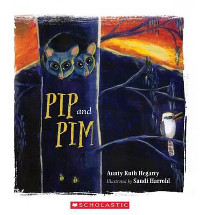Pip and Pim by Aunty Ruth Hegarty

Ill. by Sandi Harrold. Scholastic Australia, 2015. ISBN
9781760151973
(Age: 4-9) Aunty Ruth Hegarty is an Aboriginal elder, and while this
is not a dreaming story, it retains a similar style and moralistic
purpose. The dark artwork on canvas is lovely and portrays the
nocturnal world of the bush. Possums Pip and Pim are going down to
the forest floor for the very first time. They scamper off
excitedly, barely taking note of Papa's warning to look and listen
for danger and not to go too far. On their first adventure on the
ground, they meet many other nocturnal animals, all of whom are too
busy to play with Pip and Pim. They are getting further and further
away when Pim accidently stumbles into a plover's nest and arouses
the ire of Father Plover. They quickly head back to their parents
and their tree, where Papa gently reminds them of his directive not
to go too far. On the following page, Aunty Ruth Hegarty highlights
the moral of the story, which is to listen to your elders, but this
lesson does not seem to come through clearly enough in the story.
Older children may realise that Pip and Pim will be more careful
next time they venture out on the forest floor, but younger children
are more likely to enjoy their adventure without noticing the moral
teaching. While the text is quite long, it is simple and easy to
follow. It also manages to integrate some information about
nocturnal Australian animals by detailing what the various animals
are doing out at night (for example, the echidnas are going to an
anthill and the bandicoots are digging holes in search of food).
Teachers could use this with younger children as an introduction to
nocturnal animals and its inclusion of familiar native animals such
as possums and echidnas as well as lesser-known ones such as curlew
and plover could make it a good one for introducing Australian
animals.
Nicole Nelson